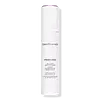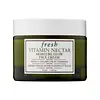What's inside
What's inside
 Key Ingredients
Key Ingredients

 Benefits
Benefits

 Concerns
Concerns

 Ingredients Side-by-side
Ingredients Side-by-side

Water
Skin ConditioningButylene Glycol
HumectantDipropylene Glycol
HumectantGlycerin
HumectantHydrogenated Polydecene
EmollientTriethylhexanoin
MaskingHdi/Trimethylol Hexyllactone Crosspolymer
Dimethicone
EmollientDipeptide-15
Skin ConditioningGlyceryl Stearate Se
EmulsifyingTrehalose
HumectantTocopherol
AntioxidantSaccharum Officinarum Extract
MoisturisingCitrus Aurantium Dulcis Fruit Extract
MaskingCitrus Limon Fruit Extract
MaskingSodium Hyaluronate
HumectantMorinda Citrifolia Leaf Extract
Skin ConditioningLeuconostoc/Radish Root Ferment Filtrate
AntimicrobialAcer Saccharum Extract
Skin ConditioningVaccinium Myrtillus Fruit Extract
Skin ConditioningSalvia Hispanica Seed Extract
EmollientGluconolactone
Skin ConditioningChondrus Crispus Extract
Skin ConditioningAminopropyl Dimethicone
Betaine
HumectantSodium Metabisulfite
AntioxidantIsostearic Acid
CleansingCoconut Acid
CleansingPEG-5 Glyceryl Stearate
EmulsifyingBehenyl Alcohol
EmollientStearic Acid
CleansingCarbomer
Emulsion StabilisingXanthan Gum
EmulsifyingPotassium Hydroxide
BufferingBehenic Acid
CleansingSilica
AbrasiveDisodium EDTA
Sodium Benzoate
MaskingPhenoxyethanol
PreservativeWater, Butylene Glycol, Dipropylene Glycol, Glycerin, Hydrogenated Polydecene, Triethylhexanoin, Hdi/Trimethylol Hexyllactone Crosspolymer, Dimethicone, Dipeptide-15, Glyceryl Stearate Se, Trehalose, Tocopherol, Saccharum Officinarum Extract, Citrus Aurantium Dulcis Fruit Extract, Citrus Limon Fruit Extract, Sodium Hyaluronate, Morinda Citrifolia Leaf Extract, Leuconostoc/Radish Root Ferment Filtrate, Acer Saccharum Extract, Vaccinium Myrtillus Fruit Extract, Salvia Hispanica Seed Extract, Gluconolactone, Chondrus Crispus Extract, Aminopropyl Dimethicone, Betaine, Sodium Metabisulfite, Isostearic Acid, Coconut Acid, PEG-5 Glyceryl Stearate, Behenyl Alcohol, Stearic Acid, Carbomer, Xanthan Gum, Potassium Hydroxide, Behenic Acid, Silica, Disodium EDTA, Sodium Benzoate, Phenoxyethanol
Water
Skin ConditioningGlycerin
HumectantPentylene Glycol
Skin ConditioningEthylhexyl Isononanoate
EmollientPolyglyceryl-6 Stearate
EmollientPolyglycerin-3
HumectantCaprylic/Capric Triglyceride
MaskingJojoba Esters
EmollientPropanediol
SolventSodium Polyacrylate
AbsorbentEthylhexyl Palmitate
EmollientStearic Acid
CleansingCaprylyl Glycol
EmollientChlorphenesin
AntimicrobialPolyglyceryl-6 Behenate
Emulsion StabilisingAcrylates/C10-30 Alkyl Acrylate Crosspolymer
Emulsion StabilisingParfum
MaskingSodium Stearoyl Glutamate
CleansingTocopheryl Acetate
AntioxidantXanthan Gum
EmulsifyingTrisodium Ethylenediamine Disuccinate
Glucosyl Hesperidin
HumectantLimonene
PerfumingSodium Hydroxide
BufferingAscorbyl Tetraisopalmitate
AntioxidantPanthenol
Skin ConditioningSodium Hyaluronate
HumectantMagnesium Aspartate
Skin ConditioningZinc Gluconate
Skin ConditioningVaccinium Myrtillus Fruit Extract
Skin ConditioningLinalool
PerfumingCaramel
Cosmetic ColorantSaccharum Officinarum Extract
MoisturisingCopper Gluconate
Skin ConditioningCitral
PerfumingCitrus Aurantium Dulcis Fruit Extract
MaskingCitrus Limon Fruit Extract
MaskingTocopherol
AntioxidantAcer Saccharum Extract
Skin ConditioningWater, Glycerin, Pentylene Glycol, Ethylhexyl Isononanoate, Polyglyceryl-6 Stearate, Polyglycerin-3, Caprylic/Capric Triglyceride, Jojoba Esters, Propanediol, Sodium Polyacrylate, Ethylhexyl Palmitate, Stearic Acid, Caprylyl Glycol, Chlorphenesin, Polyglyceryl-6 Behenate, Acrylates/C10-30 Alkyl Acrylate Crosspolymer, Parfum, Sodium Stearoyl Glutamate, Tocopheryl Acetate, Xanthan Gum, Trisodium Ethylenediamine Disuccinate, Glucosyl Hesperidin, Limonene, Sodium Hydroxide, Ascorbyl Tetraisopalmitate, Panthenol, Sodium Hyaluronate, Magnesium Aspartate, Zinc Gluconate, Vaccinium Myrtillus Fruit Extract, Linalool, Caramel, Saccharum Officinarum Extract, Copper Gluconate, Citral, Citrus Aurantium Dulcis Fruit Extract, Citrus Limon Fruit Extract, Tocopherol, Acer Saccharum Extract
Ingredients Explained
These ingredients are found in both products.
Ingredients higher up in an ingredient list are typically present in a larger amount.
We don't have a description for Acer Saccharum Extract yet.
Citrus Aurantium Dulcis Fruit Extract is more commonly known as the bitter orange. Native to Southeast Asia, this extract is commonly found in both cosmetics and foods.
The bitter orange possesses antibacterial and antioxidant properties.
It can also be mildly exfoliating due to the citric acid, an AHA.
Citrus fruits are rich in flavonoids, alkaloids, and vitamin C.
Learn more about Citrus Aurantium Dulcis Fruit ExtractCitrus Limon Fruit Extract comes from lemons. While lemon extract is exfoliating and antimicrobial, it can also cause skin sensitivity.
Lemons contains antioxidants, which may help with anti-aging. They are also rich in citric acid, an AHA.
And of course, lemons are rich in Vitamin C. Vitamin C helps with skin-brightening and increasing collagen production.
The acidity of lemons may work as an astringent for acne.
However, lemons can also cause skin sensitivity due to its limonene content. It can also increase photosensitivity, or sensitivity to the sun.
This ingredient is also used to add a lemon scent to products.
Learn more about Citrus Limon Fruit ExtractGlycerin is already naturally found in your skin. It helps moisturize and protect your skin.
A study from 2016 found glycerin to be more effective as a humectant than AHAs and hyaluronic acid.
As a humectant, it helps the skin stay hydrated by pulling moisture to your skin. The low molecular weight of glycerin allows it to pull moisture into the deeper layers of your skin.
Hydrated skin improves your skin barrier; Your skin barrier helps protect against irritants and bacteria.
Glycerin has also been found to have antimicrobial and antiviral properties. Due to these properties, glycerin is often used in wound and burn treatments.
In cosmetics, glycerin is usually derived from plants such as soybean or palm. However, it can also be sourced from animals, such as tallow or animal fat.
This ingredient is organic, colorless, odorless, and non-toxic.
Glycerin is the name for this ingredient in American English. British English uses Glycerol/Glycerine.
Learn more about GlycerinThis ingredient is also called sugarcane extract. It is a moisturizing humectant and has skin soothing properties.
Similar to hyaluronic acid, sugarcane can attract moisture to your skin.
Glycolic acid is a derivative of sugarcane. While glycolic acid is an AHA with exfoliating properties, sugarcane is not an AHA.
A study from 2021 found the compounds in sugarcane extract to have antioxidant, antimicrobial, and anti-inflammatory activity. The study also suggests these compounds can inhibit skin ageing enzymes and promote collagen synthesis.
Learn more about Saccharum Officinarum ExtractSodium Hyaluronate is hyaluronic acid's salt form. It is commonly derived from the sodium salt of hyaluronic acid.
Like hyaluronic acid, it is great at holding water and acts as a humectant. This makes it a great skin hydrating ingredient.
Sodium Hyaluronate is naturally occurring in our bodies and is mostly found in eye fluid and joints.
These are some other common types of Hyaluronic Acid:
Learn more about Sodium HyaluronateStearic Acid is a fatty acid. It is an emollient, emulsifier, and texture enhancer.
As an emollient, stearic acid helps soften skin. It aids the skin's protective barrier by preventing water loss. It also provides a gentle cleansing effect without stripping away natural oils.
Stearic acid may also be used to enhance the texture of products. It can add volume and stabilize ingredients such as water and oil. This can help water and oil ingredients from separating.
Sources of stearic acid include animal or vegetable fats/oils such as coconut or shea. It can be naturally found in butter, cocoa butter, shea butter, vegetable fats, and animal tallow.
This ingredient may not be Malassezia folliculitis, or fungal-acne safe.
Learn more about Stearic AcidTocopherol (also known as Vitamin E) is a common antioxidant used to help protect the skin from free-radicals and strengthen the skin barrier. It's also fat soluble - this means our skin is great at absorbing it.
Vitamin E also helps keep your natural skin lipids healthy. Your lipid skin barrier naturally consists of lipids, ceramides, and fatty acids. Vitamin E offers extra protection for your skin’s lipid barrier, keeping your skin healthy and nourished.
Another benefit is a bit of UV protection. Vitamin E helps reduce the damage caused by UVB rays. (It should not replace your sunscreen). Combining it with Vitamin C can decrease sunburned cells and hyperpigmentation after UV exposure.
You might have noticed Vitamin E + C often paired together. This is because it is great at stabilizing Vitamin C. Using the two together helps increase the effectiveness of both ingredients.
There are often claims that Vitamin E can reduce/prevent scarring, but these claims haven't been confirmed by scientific research.
Learn more about TocopherolVaccinium Myrtillus Fruit Extract comes from the bilberry plant. This plant is native to Eurasia.
Bilberry contains antioxidant compounds called anthocyanins. Anthocyanins help fight free-radicals. Free-radicals are molecules that may damage your skin cells. Fighting off these molecules can help reduce signs of aging.
Vaccinium Myrtillus Fruit Extract also helps reduce irritation.
Learn more about Vaccinium Myrtillus Fruit ExtractWater. It's the most common cosmetic ingredient of all. You'll usually see it at the top of ingredient lists, meaning that it makes up the largest part of the product.
So why is it so popular? Water most often acts as a solvent - this means that it helps dissolve other ingredients into the formulation.
You'll also recognize water as that liquid we all need to stay alive. If you see this, drink a glass of water. Stay hydrated!
Learn more about WaterXanthan gum is used as a stabilizer and thickener within cosmetic products. It helps give products a sticky, thick feeling - preventing them from being too runny.
On the technical side of things, xanthan gum is a polysaccharide - a combination consisting of multiple sugar molecules bonded together.
Xanthan gum is a pretty common and great ingredient. It is a natural, non-toxic, non-irritating ingredient that is also commonly used in food products.
Learn more about Xanthan Gum